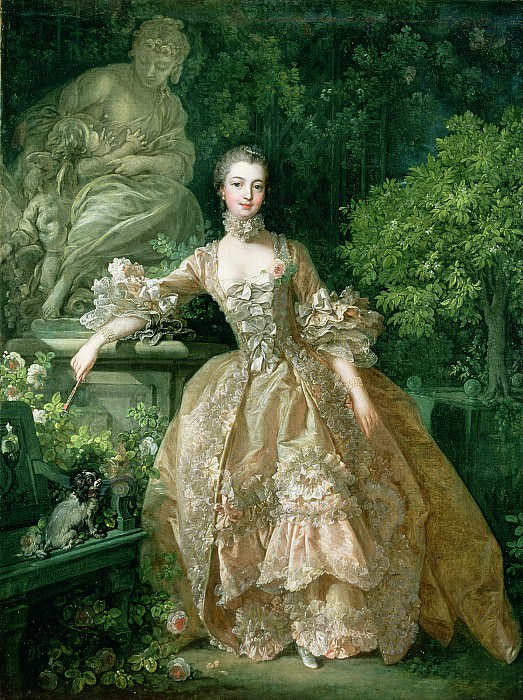Portrait of Marquise de Pompadour Francois Boucher (1703-1770)
Francois Boucher – Portrait of Marquise de Pompadour
Edit attribution
Download full size: 1492×2000 px (1,1 Mb)
Painter: Francois Boucher
The French painter Boucher was not very keen on painting portraits. However, he loved to paint a picture of his patroness, Louis XV’s favorite, the Marquise de Pompadour. He began his work with her in 1748. From 1752 Boucher began to live and work in the Louvre (the Marquise de Pompadour herself took care of this). Despite the fact that she was the king’s mistress for only 5 years, she continued to be a person of great influence and connections in France until the death of King Louis XV.
Description of the painting "Portrait of the Marquise de Pompadour" by François Boucher
The French painter Boucher was not very keen on painting portraits. However, he loved to paint a picture of his patroness, Louis XV’s favorite, the Marquise de Pompadour.
He began his work with her in 1748. From 1752 Boucher began to live and work in the Louvre (the Marquise de Pompadour herself took care of this). Despite the fact that she was the king’s mistress for only 5 years, she continued to be a person of great influence and connections in France until the death of King Louis XV. She was a woman of contrasting qualities: she was intelligent, diplomatic, educated, cynical, despotic, and a great deal of influence.
Boucher pleased her by depicting the Marquise on all his canvases with the face of a 20-year-old girl.
Her portraits are the French artist’s works, which can be safely shown to children under the age of 16. All the other works of the painter Boucher are slightly frivolous - he liked to portray naked girls and young men, to paint scenes with an erotic character.
The painting "Portrait of the Marquise de Pompadour" - this is her last portrait. For a time the painting with her portrait was housed in Versailles. After the death of the Marquise de Pompadour, the canvas went to her brother.
The portrait depicts an intelligent, educated, tasteful young woman. As seen and tried to portray in all the portraits with her painter Boucher. The Marquise herself admitted that he painted her not as she really is. The portrait is painted with the preservation of all the features of the traditional ceremonial portrait.
The canvas was painted in oil on canvas in 1759. The size of the painting is 130x162 cm.
Кому понравилось
Пожалуйста, подождите
На эту операцию может потребоваться несколько секунд.
Информация появится в новом окне,
если открытие новых окон не запрещено в настройках вашего браузера.
You need to login
Для работы с коллекциями – пожалуйста, войдите в аккаунт (open in new window).




















You cannot comment Why?
The Marquise is dressed in a luxurious, fashionable gown of pale gold silk, adorned with intricate lace, bows, and ruffles that cascade down her voluminous skirt. Her posture is relaxed yet poised, with one hand delicately holding a fan. Her gaze is directed towards the viewer, conveying a sense of confidence and self-possession.
To her left, a small, dark-colored dog sits attentively on a dark green bench, adding a touch of domestic intimacy to the scene. Behind her, a classical marble statue, possibly depicting Venus and Cupid, stands partially obscured by foliage, hinting at themes of love and beauty. The rich, dark green of the garden creates a striking contrast with the luminous fabric of her dress, drawing attention to her radiant presence.
The subtext of the painting is multifaceted. It is, first and foremost, a portrait of a powerful and influential woman, Madame de Pompadour, the chief mistress of King Louis XV. The opulent attire, the refined setting, and the presence of the statue all serve to emphasize her elevated status, wealth, and sophisticated taste. The title of the painting, specifying her former home, Marigny, might suggest a nostalgic or possessive connection to her past, or perhaps a subtle assertion of her independence and influence beyond her role as royal mistress.
The idyllic garden setting, combined with the roses and the statue of Venus, evokes a sense of sensuality and romance, aligning with her public persona and her relationship with the King. Yet, the slightly wistful or enigmatic expression on her face, coupled with the presence of the dog and the fan, can also suggest an underlying vulnerability or a contemplative mood. The painting, therefore, not only celebrates her beauty and stature but also hints at the complexities of her life, her power, and her personal feelings within the rigid structure of the French court.